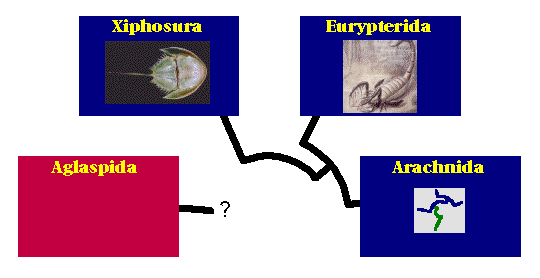



Cheliceramorpha: Systematics, Part 1






There are a number of Cambrian fossils that indicate that the Cheliceramorpha was once much more diverse than it is now; these fossils do not fit into any of the above clades. For purposes of clarity, we have left them out of this cladogram, especially since their precise systematic position is debatable and subject to change (specialists should consult Wills et al., 1994).
Traditionally, the Xiphosurida (horseshoe crabs) and Eurypterida (sea scorpions) have been grouped together in a taxon called the Merostomata, while the true scorpions have been classified in the Arachnida along with the spiders, mites, and others. All three of these taxa together form a "crown group", the Chelicerata; the Cheliceramorpha would include the Chelicerata plus all extinct lineages that are closer to it than to any other clade. The Merostomata, however, is probably a paraphyletic group. In fact, there is some evidence to suggest that the terrestrial scorpions are closely related to the eurypterids or sea scorpions (Meglitsch and Schram, 1991). Some recent findings suggest that the Aglaspida, a group whose affinities have always been problematic, may in fact be closer to the trilobites than to the other chelicerates.

Meglitsch, P.A. and Schram, F. R. 1991. Invertebrate Zoology, Third Edition. Oxford University Press, Oxford and New York.
Shultz, J.W. 1990. Evolutionary morphology and phylogeny of the Arachnida. Cladistics 6: 1-38.
Wills, M. A., D. E. G. Briggs, and R. A. Fortey. 1994. Disparity as an evolutionary index: a comparison of Cambrian and Recent arthropods. Paleobiology 20(2): 93-130.

